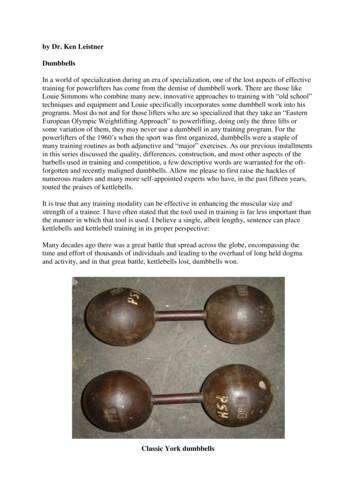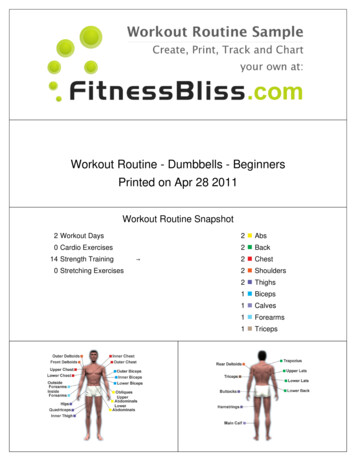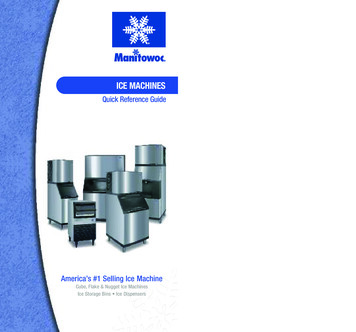
Transcription
by Dr. Ken LeistnerDumbbellsIn a world of specialization during an era of specialization, one of the lost aspects of effectivetraining for powerlifters has come from the demise of dumbbell work. There are those likeLouie Simmons who combine many new, innovative approaches to training with “old school”techniques and equipment and Louie specifically incorporates some dumbbell work into hisprograms. Most do not and for those lifters who are so specialized that they take an “EasternEuropean Olympic Weightlifting Approach” to powerlifting, doing only the three lifts orsome variation of them, they may never use a dumbbell in any training program. For thepowerlifters of the 1960‟s when the sport was first organized, dumbbells were a staple ofmany training routines as both adjunctive and “major” exercises. As our previous installmentsin this series discussed the quality, differences, construction, and most other aspects of thebarbells used in training and competition, a few descriptive words are warranted for the oftforgotten and recently maligned dumbbells. Allow me please to first raise the hackles ofnumerous readers and many more self-appointed experts who have, in the past fifteen years,touted the praises of kettlebells.It is true that any training modality can be effective in enhancing the muscular size andstrength of a trainee. I have often stated that the tool used in training is far less important thanthe manner in which that tool is used. I believe a single, albeit lengthy, sentence can placekettlebells and kettlebell training in its proper perspective:Many decades ago there was a great battle that spread across the globe, encompassing thetime and effort of thousands of individuals and leading to the overhaul of long held dogmaand activity, and in that great battle, kettlebells lost, dumbbells won.Classic York dumbbells
It really is that simple. The fact, and it is a fact, that a balanced dumbbell allows for safer,more efficient, more effective, and a greater variety of training made it the overwhelmingchoice of those who lifted heavy objects for the purpose of providing exercise that wouldmake them stronger. From the late 1930‟s or at least by the end of the Second World War,until the mid-1990‟s, you would have to trip over an elderly man‟s stored possessions in adarkened, dusty basement to find a kettlebell in the United States. They were relics and rightlyso. The limitations placed upon the trainee were too great to make them commercially viablein the gym business and most serious powerlifters and bodybuilders discovered that if theywere going to do exercises where their choice fell between dumbbells and kettlebells, therewas no choice, dumbbells would be used. When it became “fashionable” in the fitnessindustry and allow me please, to state that again and stress the term “fitness industry,” to liftand move heavy, awkward objects, someone‟s light bulb went on and an entire new cottageindustry was born. A series of articles in mid-1980‟s issues of Muscular DevelopmentMagazine will indicate that I was in the forefront of what has unfortunately come to be called“functional training” because many of my trainees were asked to traverse our lengthydriveway while pushing what appeared to be a friction controlled lawn mower, flipping heavytires, carrying sections of I-beam that I had welded handles to, dragging sections of anchor orrigging chain, and “finishing” with car or truck pushing on our street. I have never beencomfortable with the term “functional training” because all productive training is functional.These “total body movements” were just hard work exercises done at a high level of intensitythat made me get to the brink of “total annihilation,” a way to push myself even harder thanthe high rep squats might have done, thus, I adapted the types of heaving and carrying I did onthe job with my father. The comments and letters sent to Muscular Development in 1985 or sowere often of the “ what the hell is this stuff and why are you publishing it?” ilk as much asthey were complimentary relative to coming up with something “different.”
The great Sig Klein presses old fashioned but very effective dumbbells,circa 1940'sAs a high school and college student seeking to become bigger and stronger (without realizingI would also become significantly faster), I would walk or run up the steep, long stairway tothe loft of my father‟s iron shop holding a York 100 pound dumbbell in each hand; I wouldsquat and then push my car up and down the street that we lived on (and to paraphrase from adecades old article, “ to the delight and consternation of my neighbors” as I often vomitedeither immediately after or while performing this specific exercise); I would farmers walk(and I will reiterate and again negate the claim of another that I came to name that exercise, asthe name existed long before I did) various sections of beam to which I had welded handles.All of the above movements and exercises like them can be done progressively, intensely, andin a way that stimulates changes in one‟s physiology, they are all useful. However,“functional training” has now come to be spoken of as if it is both a specialized and veryspecial, exotic means to add to one‟s levels of strength and fitness. Kettlebells are right in the
middle of this mix and more than any other “functional modality,” kettlebells have become a“be-all and end-all” for many in the fitness field.Sig Klein presses a kettlebell, circa 1940'sKettlebells can certainly add variety to a session, as can any other unusual or infrequentlyused object. There are some effective exercises like swings, presses, cleans, and even curlsthat can be done but one could make the case that the same movements are as effective and inmany if not most cases, more effective and safer if performed with dumbbells. There is nodoubt that dumbbells are easier to handle and thus safer to handle. Kettlebell proponents willmake their case that it is the relative inefficiency of handling the implement that makeskettlebell training effective. For any so-called advantage in performing a kettlebell movementin place of the same dumbbell movement in order to “give work to the small supportivemuscles,” or “to add to the balance factor” one also suffers a decrease in training efficiencyand intensity as well as focus upon the targeted musculature. Let me add here that in myopinion, one that obviously there will be disagreement with (especially from those who ownor operate “all kettlebell gyms”), kettlebells can be an enjoyable way to add variety and a bitof fun to a workout. If a dumbbell press is a “good” exercise, a kettlebell press can be a“good” exercise. The dumbbell is an obviously more effective and safer tool where eitherimplement can be used but I am not saying that “all kettlebell” training cannot be effective.There are some true physical specimens, strong, enduring, and flexible who have done themajority of their training with the ancient implements proving that but I would also quicklycontend that they would have done as well if not better with a more efficient tool.
Monster kettlebellWhile this brief piece will set the internet chat boards buzzing and the new wave of fitnessentrepreneurs and strength gurus hollering, especially those tied to commercial interests thatsell kettlebells, kettlebell training courses, kettlebell seminars, and perhaps newly mintedkettlebell attire screaming in protest and pointing fingers in my direction while using phraseslike “know-nothing,” without the commercial and finance generated push kettlebell traininghas received only since the mid-1990‟s, these objects would still be no more than a footnote tothe history of the Iron Game. What some also don‟t know is that dumbbells, like barbells andplates, have varied in type, quality, construction, and ease of use since their introduction to thestrength and powerlifting world. As a footnote to this specific column it should be noted thatmy lovely and insightful wife Kathy noted the same disadvantages of kettlebell training whilepredicting it would “be the next big thing” in the commercial arena, way back in a 1987 issueof our STEEL TIP NEWSLETTER thus the more things change, the more they remain thesame!More DumbbellsI could make the obvious joke and point out the knee jerk reaction of many in the strengthcommunity who said, “Yeah, Dr. Ken wrote about dumbbells from a lot of self knowledge, he
is a dumbbell because of his adversity to kettlebells!” To me that would have been funny butallow me to be brief and clear. There is nothing “wrong” or incorrect about doing any trainingwith kettlebells but it is not an efficient tool and for some applications not a safe tool relativeto the use of a dumbbell. Again, I will relate to the fact, and it certainly is an undeniable fact,especially for those of us old enough to have lived through the so-called “Golden Age OfTraining” of the mid-1950‟s to late „60‟s, that you just never saw a kettlebell unless it wasstored in an elderly former lifter‟s basement, or stuck in a corner at the local YMCA. I canrecall reading some of the 1961 and 1962 Weider magazines when he was selling “kettlebellhandles” that could be attached to one‟s adjustable dumbbell bar.Vintage Weider bodybuilding adThe “science” behind the handles, and that‟s a word not to be thrown around too seriouslywhen it comes to the Weider pronouncements and so-called “research” circa 1960‟s, not whenthe Weider Research Clinic was little more than a sign on a broom closet, was based on a
change in leverage that the handles would allow. This in turn would make the exercise moreeffective. Well, if one makes a movement less efficient, yes, it can be construed as being moredifficult, especially if it drifts into the descriptive arena of “awkward” but even then, thehandles were a hard sell and had few takers. By the late 1960‟s, the only kettlebell handleoffering made by Weider was as a pair of handles included as part of the “Superior Big 16”barbell-dumbbell sets offered and the advertising line was “Kettlebell Set for broad, he-manshoulders.” The “sell” was the suggestion to use the handles for lateral raises or front raises,thus the reference to broad shoulders, as their use was otherwise limited. Eventually thehandles fell both out of use and the Weider catalogue of products. Dumbbells however, couldbe found anywhere that weights were lifted, including the York Barbell Club where Olympicweightlifting ruled the day.Dumbbells, like barbells, have varied in materials, construction, quality, and shape throughouttheir history. My wife disappeared for an hour or two on a Saturday afternoon this past falland excitingly returned to the house with the announcement that our neighborhood washaving three simultaneous garage sales within a few blocks of our home. This was notthrilling news to me but I more or less humored her and asked what had been such an“exciting” find. For the grand total of fifty cents, she had purchased a pair of woodendumbbells that she dug out of a pile of “stuff” and the owners were more than happy to seethe dumbbells leave their premises for that princely sum. My very intelligent and industriouswife immediately fell into the research and her exciting find proved in fact to be just that: apair of wooden one pound dumbbells manufactured approximately ninety years ago byStandard Narragansett Machine Company of Providence, Rhode Island. A great discovery andan indication that from the first use of hand held weights or dumbbells, the materials usedwere limited only by the availability of what was in the locale and the imagination of the useror maker.Vintage wooden bumbellsAlthough a number of lengthy treatises have been written about dumbbells and their origins, Ihave no doubt that they have been manufactured or “home made” using wood, iron, stones,
cement, and possibly old cannon balls! If one looks at the mid to late 1940‟s editions ofStrength And Health Magazine, large scale “weight training” was undertaken by the militaryto hasten the troops‟ preparation for entry into combat. They utilized what we might presentlyterm “circuit training” and had the troops in basic training doing barbell exercises with“barbells” made from concrete filled soup cans that were attached to the ends of a length ofpipe. I am quite certain that photos could be found of hand-held weights/dumbbells made inthe same manner. I know that many of my early dumbbells were made in my father‟s ironshop from either scrap pieces of solid round stock or pipe to which I welded inside andoutside collars and the appropriate number of plates so that I had a rather extensive set ofpermanent dumbbells.Brian Saxton, former Atlanta Falcons, NY Giants, and Boston College tight endpresses with Dr. Ken’s homemade pipe-and-plates dumbbellsFor those who have in fact made their own dumbbells, it quickly becomes obvious that onecannot “just make dumbbells” if they want to do so safely. The first order of business wouldbe to accumulate enough plates to make the neccessary number of dumbbells in the desireddenominations. From seventh grade onward, I became very proficient and persistent atdogging the guys in school whom I knew lifted weights. The standard barbell and dumbbellsets that were sold at local sporting goods stores and the occasionally stocked departmentstore consisted of a five foot bar, two short dumbbell bars, inside and outside screw-on collarsfor the three bars, and enough plates to construct what was advertised as a “110 Pound Set.” Itusually did not take more than a month or two before the erstwhile Man Mountain Deanswould give up their quest for Herculean size and strength, and another few weeks past thatuntil they were ready to recoup some of the monetary investment they had put into theirbarbell set. Usually these wound up under the bed, in the rear of a closet, or stuffed behindother little used items in the garage or basement. I would volunteer
training for powerlifters has come from the demise of dumbbell work. There are those like Louie Simmons who combine many new, innovative approaches to training with “old school” techniques and equipment and Louie specifically incorporates some dumbbell work into his programs. Most do not and for those lifters who are so specialized that they take an “Eastern European Olympic .











